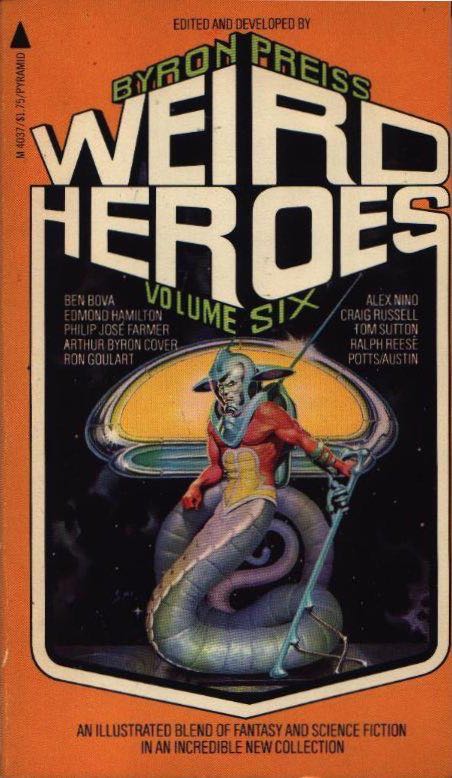Weird Heroes volume 6
Reviewed date: 2004 Aug 25
320 pages
A fiction writer's most valuable possessions are his created worlds and characters. Writers guard their creations closely, only rarely letting other writers use them. In this way writers maintain some control over the artistic quality and reputation of the creations that put food on their table. When a character or world gains a large built-in audience of fans, various rights to use that character are generally sold--often to a movie studio, or perhaps to a writing house that will continue to produce stories. For example, the success of The Wizard of Oz led to numerous sequels, only some of which were written by L. Frank Baum.
The point of all this being that writers must toil along to create their own worlds and characters, or they can be hired to write stories about someone else's character. Most writers would prefer to write their own stories, but the built-in audiences of the stock characters generally offer the writer a guaranteed income.
Byron Preiss, editor of Weird Heroes, seems not to understand what it is about ready-made characters that is attractive. It's the built-in audience, of course. But no, Mr. Preiss doesn't understand. In the opening forward, he relates how he discovered the character of Shinbet. He was visiting a friend who showed him a sketch of a strange man. Mr. Preiss immediately decided he wanted to buy this character. Is it because this character had a huge built-in audience that could bring him money? No, this character never existed anywhere except in one little sketch. No ready-made audience, thus there is no reason in the world to pay good money for someone else's character rather than make up your own. But no, Mr. Preiss bought the sketch and the rights to the character.
Well, perhaps this character is so compelling that Mr. Preiss knew he would be a hit. Ha, not likely. See, the entirety of the character can be summed up in two words: snake man. Yes, this beloved character that Mr. Preiss bought is nothing more than a snakeman. Upper body of a man, but instead of legs he has a huge snake body. Yeah, real brilliant. Come to think of it, I have some character ideas for sale. How about this one: Chickenman. Body of a man, legs of a chicken. Or how about Dogs-for-legs. See, instead of legs he has two dogs attached to his body. Far out!
The story about Snakeman, Shinbet Investigates, is a terrible story. But what really seals it is that the Snakeman character adds nothing to the story. There is nothing that Snakeman does that a regular man couldn't. In fact, his snakeness never actually comes into play at all. So Mr. Preiss spent buckets of money for Snakeman, hired Ron Goulart to write the story, and ended up with a novelette that would have been better without Snakey.
After all that, surely the other stories in this collection cannot be as bad? They are not, but some come close. Ben Bova's Orion is a stupid fantasy time travel story. Phillip José Farmer's Greatheart Silver in the First Command is a fun adventure story whose hero is a zeppelin captain. Galactic Gumshoe, by Arthur Byron Cover, is a formulaic retelling of Beowulf.
Strangely enough, Galactic Gumshoe includes a secondary off-stage character named Hare Seldon. That sounds suspiciously like Hari Seldon from Isaac Asimov's Foundation series. I'm not sure if the inclusion of Hare Seldon is meant as an homage to Asimov, but to me it looks suspiciously like a second-rate writer trying to cash in on the name recognition of another man's property. Bad, bad Mr. Arthur Byron Cover.
I do not recommend Weird Heroes volume 6.
